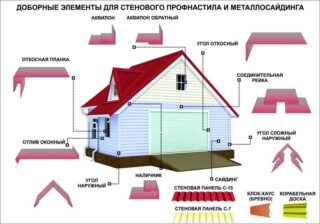Profiled sheeting is in demand in modern construction, because it has acceptable technical and aesthetic characteristics. Sheathing the house with a profiled sheet from the outside additionally insulates the walls, levels the plane, and gives a beautiful look. The basis of the metal sheet is galvanized steel, the panels are perforated to increase rigidity. The surface is covered with polymer compounds, so the material resists the action of the atmosphere and ultraviolet radiation.
- Varieties of professional sheet
- Instructions for sheathing the house with profiled sheet
- Calculation of materials
- Required set of elements
- List of instruments
- Surface preparation for finishing
- Installation of the supporting frame for a wooden house
- Installation of a supporting frame for a brick house with insulation
- Finishing the facade with profiled sheet
- Laying the profiled sheet on the pediment
- Installation of additional elements on openings and corners of the facade
- Installation recommendations
Varieties of professional sheet
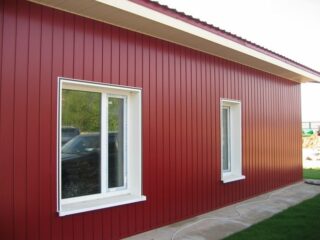
The universal material is used for the walls of trade pavilions, production workshops, cladding of facades of private houses. Waves on the surface are rectangular, square, rounded. The scope of application depends on the properties of the profiled sheet.
The marking contains letters and numbers:
- the first letter speaks of the purpose (C - wall, H - carrier, NS - universal);
- the first digit is the wave height in mm;
- the second is the thickness of the steel;
- the third is the width of the panel;
- the fourth is the length of the strip.
Wall profiled sheet is produced with wave height from 8 to 44 mm. The width is from 1.0 to 1.2 meters, the weight of the square is 4.6 - 7.4 kg, the wall thickness is 0.5 - 0.7 mm.
The load-bearing version can withstand great efforts without deformation, it is mounted as a roof covering, and is installed for permanent formwork of floors. Wave height - 60 - 114 mm. Sheets are produced with a width of 0.6 - 0.845 m, a square weighs 8.8 - 14.5 kg, walls with a thickness of 0.7 - 0.9 mm.
The material of the universal category is suitable for roofs and walls, the perforation height is 35 - 44 mm. The width of the strips is 1.0 m, the weight per square meter is 5.4 - 8.5 kg, the sheet thickness is 0.5 - 0.7 mm.
Instructions for sheathing a house with a profiled sheet
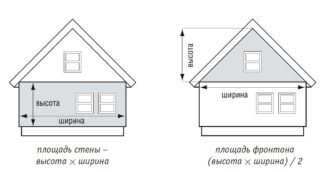
The cladding of the facade with a profiled sheet is done according to the principle of a hinged frame. It is possible to mount panels directly to walls if they have a perfectly flat surface, but this is rarely the case.
When performing a hinged frame, a number of issues are resolved:
- the lathing compensates for the unevenness of the vertical fences of the building;
- the corrugated board on the frame does not collapse when the wooden structure shrinks;
- it becomes possible to install insulation in order to move the dew point outward from the wall.
Insulation additionally isolates from noise. A vapor barrier, a waterproofing membrane is placed on the walls, and wind protection is mounted. As a result, the building receives protection several times higher than when finishing without a frame.
Calculation of materials
For the calculation, the area of the walls is taken, for which the quadrature of each section of the facade is calculated, then the values are added. The area of the gables is added. The area of window and door openings is not removed from the square, otherwise trimming will have to be used for facing the outer slopes. This does not add to the attractiveness of the appearance.
The required type of corrugated board is chosen, the useful area of one strip is determined. The total squaring of the walls is divided by the indicator for one piece, the number of panels is obtained. The result is multiplied by 1.1 or 1.2, depending on the complexity of the facade. The result is rounded to the nearest whole number of elements.
Sometimes it is better to do a full layout of the layout of the sheets to see how the cutting will go. This is especially important when calculating strips for sheathing the gable with corrugated board.
Required set of elements
Types of parts:
- Inside and outside corner planks with rolled edges. It is produced in lengths of 2.0 and 3.0 m, the width of the side edges is 115 x 115, 75 x 75, 50 x 50, 30 x 30 mm.
- The outer corner is produced with sides of different widths, set perpendicular to one another. The semicircular part has additional stiffening ribs. The width of the shelves is 1.15 m, the length of the element is 2.0 and 3.0 m.
- The inner corner is similar to the previous element, but its concave part serves as the front side. Side width 1.15 m, length 2.0 and 3.0 m.
- The plinth ebb plank has dimensions of 240 x 30, 210 x 30, 180 x 30, 150 x 30, 50 x 20 mm, length - 2.0 m.
Aquilon planks, window elements and eaves are also used. If the profiled sheet is placed vertically, the corner elements are chosen according to the height of the wave so that they overlap at least one corrugation.
List of instruments
To mark the walls, use a regular tape measure or laser. The correctness of the installation is checked with a building level and a plumb line.
Prepare other instruments:
- scissors for iron, hacksaw for metal;
- hand circular or other electric tools for cutting galvanized with a polymer layer;
- cord, hammer, pliers;
- drill, puncher, screwdriver.
Right angles on the profiled sheet are marked with a square. It is impossible to cut sheets with a grinder, since the protective layer is destroyed.
Surface preparation for finishing
On the facade, protruding parts are removed, lamps and wires are removed. Platbands and ebbs are removed from door and window openings. If tree branches reach the walls, they are tied up or cut down. From above, the hinged water intake boxes are removed from the roof.
The surface of the walls is cleaned of poorly adhered layers, dust. The cracks are deepened, sealed with repair mortar or putty for facade work. If a dowel gets into an untreated crack, the frame will loosen over time. After repairing the surface, it is primed.
Installation of the supporting frame for a wooden house
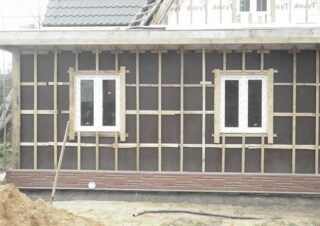
You can sheathe the wall with a profiled sheet using a lath made of wood or steel profile. For walls made of timber, boards, other sawn timber, a 25 x 50 mm rail is taken, pre-treated with linseed oil and dried.
Work order:
- Mark the position of the slats on the facade. For vertical corrugated board, horizontal supports are placed and vice versa.
- The laths are fixed to the surface using wood pads or use the ES bracket from the g / cardboard fastening system. For fixing to a wooden wall, wood screws or screws are used.
- Self-tapping screws "fleas" are used to fasten the rail to the bracket.
In the process of work, they check the verticality and horizontality, the plane is coordinated using a stretched cord on the extreme slats.
Installation of a supporting frame for a brick house with insulation
To sheathe a brick house with a profiled sheet, steel profiles are chosen. It is better and more convenient to put them, since metal elements are always even, they are not driven from moisture, they do not require preliminary impregnation.
Work order:
- Mineral wool is attached to the wall, it is nailed with mushroom dowels, then waterproofing is installed. They put staples, and fix the profiles in them.
- If you use slab polystyrene, expanded polystyrene, the frame is first mounted, then the insulation is placed between the racks. The gaps are sealed with foam, the waterproofing is attached to the frame.
Dowels with self-tapping screws are used to fix the brackets into the brick, and the profiles are screwed to each other and to the brackets with self-tapping screws.
Finishing the facade with profiled sheet
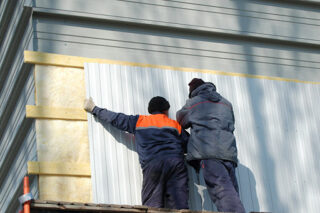
The vapor barrier and windproof film is attached to the upper part of the crate, then unwound downward, fixed to the lower part. Provide for an overlap of strips of 15 cm.
Initially, additional strips are placed on the facade for internal work, these include basement, window, corner elements, docking strips. They are fixed to the crate with self-tapping screws. Measure the place for fixing the corrugated board, cut the required pieces.
For fixing to the frame, special self-tapping screws with press washers are used. The color of the hardware is chosen to match the color of the profiled sheet. The second sheet is placed with an overlap in one wave, the fasteners are placed every 0.5 m.
Laying the profiled sheet on the pediment
The frame slats on this part of the facade are placed vertically. Insulation is carried out if it is provided on the wall of the attic. At the bottom, an additional bar is mounted in the form of a basement ebb, and it is fixed with roofing screws. A finishing strip is placed under the roof to fix the last strip on the pediment.
Measure each subsequent strip after installing the previous one along the contour of the roof. The cut piece is leaned against the frame, fixed with roofing hardware. The second is set with an overlap by one wave, the work is performed in the same way as the previous one.
Installation of additional elements on openings and corners of the facade
After the installation of the profiled sheet panels, internal, external decorative corners are installed at the intersection of the walls. Window openings are sheathed using a small Aquilon strip, it is installed on the sections of the upper and side joints of the frame with slopes. This detail helps to align the edges of the slopes.
On the pediment, cornice strips are installed on the sides of the sloping sections to close the junction with the roof. Self-tapping screws with press washers and rubber gaskets are used everywhere. They are screwed in so as not to attract too much, leaving the possibility for thermal expansion.
Installation recommendations
When buying a material, add-on strips and profiled sheet panels of the same thickness are chosen so that the cladding in the complex will serve the same time. Internal and external corners can be matched to the facade or use details of a contrasting color scheme in the form of a bright accent.
5 - 7 pieces of self-tapping screws are fastened per square meter of cladding, they are placed in the groove of the profile. Hardware is chosen with a diameter of 4.8 mm, length - 35 - 40 mm. The fastening of overhead additional elements is done carefully so as not to bend the body of the corrugated board itself. It is better to use a screwdriver with adjustable torque.

